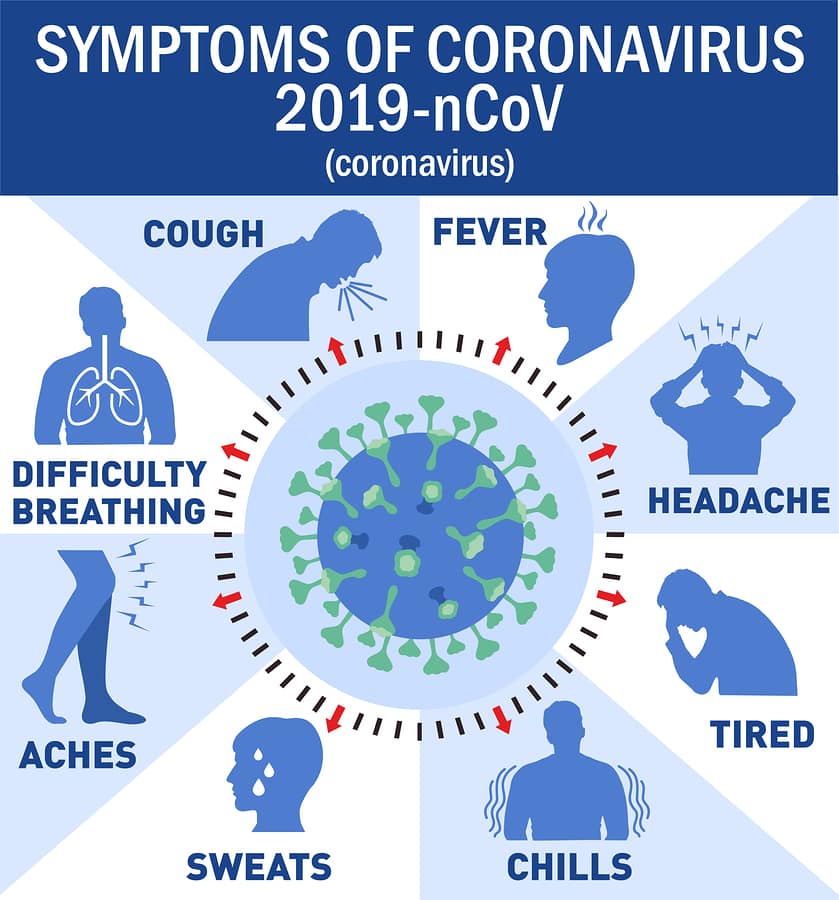Coronavirus Update From ATLC CEO

Dear Apple Tree Families:
As you may be aware, the first cases of novel coronavirus (COVID-19) have been identified this week in Hampton Roads. According to the Virginia Department of Health, the immediate risk from COVID-19 to the general public in Virginia continues to be low. Apple Tree Kids is committed to the health and safety of our students and staff and we would like to share how we are preparing for the possibility that the virus could make its way into our centers.
We have many protocols in place due to the cold and flu season, which we will continue to implement and can increase if needed. As recommended by the Centers for Disease Control and Prevention (CDC) we are:
– Monitoring student illness reports, trends and absenteeism
– Working to limit the spread of diseases whenever possible by paying extra attention to commonly-touched surfaces (door knobs, faucet handles, etc.)
– Reminding our students, staff and school community of the importance of good hand-washing procedures
– Reviewing response plans, making necessary adjustments as information becomes available.
As travel restrictions and associated actions like self and mandated quarantines are changing daily, we are strongly encouraging any of our families with travel plans over Spring Break to notify your Center Director of their travel plans and destinations so we can monitor and advise of any restrictions before returning to care at Apple Tree.
In situations like these, rumors may cause unnecessary reactions and panic. We encourage you to get information from credible sources, such as the Virginia Department of Health, the Centers for Disease Control and Prevention, and the local Health Department.
We are committed to keeping you informed and will provide email updates as new information becomes available. This is a good time to update your contact information with your child’s Center Director, as we will notify you using our Parent Alert System if there is a change to our daily operations. A closure could result if recommended by local and/or federal agencies deeming it necessary to confine an outbreak or require deep sanitizing of childcare centers. We will follow any recommendations or mandates as directed by the CDC and local Health Departments.
As we partner with you and our community to meet known and unknown challenges, we are committed to keeping the channels of communication open and doing all we reasonably can to ensure the health, safety, and well-being of our students, staff, families, and community.
If you have any questions or concerns regarding any medical or health issues, please feel free to reach out to your local health department.
Sincerely,
Heidi Riden
CEO

Focus On Food Safety

According to the Centers for Disease Control and Prevention (CDC), an estimated 48 million Americans fall sick each year from foodborne illnesses, many of which can be avoided. The good news is that there are simple steps you can take to prevent you and your loved ones from coming into contact with germs that cause food poisoning. The CDC breaks its plan for preventing foodborne illnesses into four categories: clean, separate, cook and chill.
Clean
Keeping a clean workspace can prevent germs from spreading throughout the kitchen. Clean your countertops and sink after meal preparation with a cleaning spray, and wash knives, cutting boards and other utensils thoroughly with hot, soapy water. Be sure to rinse fruits and vegetables under running water before eating. This includes fruits or vegetables you intend to peel, as rinsing them will reduce the amount of bacteria on the produce. And, of course, wash your hands prior to cooking and before you sit down to eat.
Separate
When purchasing raw meat, poultry, fish and eggs, keep them apart from other food items, both in the grocery cart and in your refrigerator at home. Use plastic bags offered at grocery stores to prevent juices from contaminating ready-to-eat groceries. While cooking, use separate cutting boards, plates and utensils when dealing with raw items.
Cook
Get to know your food thermometer—it’s the only reliable way to determine if the food you are cooking has reached a safe internal temperature. For a complete list of safe internal food temperatures for meats, poultry, seafood, leftovers and more, visit www.foodsafety.gov. When thawing foods, do so in the refrigerator, in the microwave or by cold water thawing.
Chill
After a trip to the grocery store, refrigerate perishable food within two hours of purchasing (or within one hour if the outdoor temperature is more than 90˚ Fahrenheit). Keep your refrigerator set at or below 40˚ Fahrenheit and your freezer at 0˚ Fahrenheit. Store leftovers in an airtight container and refrigerate within two hours after cooking. Eat your leftovers within a few days and never keep any leftover food for more than one week.
Enjoy A Heart-Healthy Valentines Day

This Valentine’s Day show your heart some love! February is American Heart Month—a time to raise awareness about heart disease and what people can do to prevent it. When making your plans for Valentine’s Day, choose foods and activities that are good for your heart so you and your loved ones can reap the benefits.
Research restaurants before making reservations. A romantic dinner out with your sweetheart is a popular way to celebrate Valentine’s Day. Be sure to look at the restaurant’s menu prior to making a reservation and find a few dishes that are both tasty and good for your heart. Look for nutrient-rich foods like leafy, green vegetables, whole grains or fatty fish (salmon, mackerel or tuna, for example).
Better yet, cook at home. If a crowded restaurant isn’t your scene, break out your cookbooks (or do an internet search) to find a heart-healthy meal to cook at home. By making small changes in your cooking, like choosing skinless poultry or fish, low-sodium foods and sauces and fat-free or low-fat dairy products, you can create a meal that’s good for your heart in no time.
Moderation is key. Enjoy a glass of wine or a flute of champagne, but don’t go overboard. The American Heart Association recommends no more than one drink a day for women and no more than two drinks a day for men.
Dig into a heart-healthy dessert. There are many Valentine’s Day desserts that are heart-healthy! Berries are a top contender; find them in cobblers, parfaits or even just dipped in chocolate. When it comes to chocolate desserts, opt for dark chocolate as it contains more antioxidants and minerals and (usually) less sugar than milk or white chocolate.
Take an after-dinner stroll with your loved one. Get your heart rate up after dinner by taking a walk for 20-30 minutes. The American Heart Association recommends 150 minutes of moderate exercise or 75 minutes of vigorous exercise a week for adults. Take advantage of your time together and do something that will make you both feel great.
Skip The Resolutions. Aim For Balance.

Have you made your resolutions for the new year? Typically, a resolution list includes goals that can seem out of reach. For example, you may aim to put a certain amount of money into your savings account, or lose a specific amount of weight. However, most people tend to lose sight of these goals just a few short months into the year. Instead of creating many different goals, a better option may be to make a broader, all-encompassing goal: balance.
Physical Balance
When it comes to diet and exercise, you’ve probably heard the word “balance” more than anywhere else – and with good reason! Rather than beginning the year with unattainable goals of quitting sugar, or exercising five days a week, aim for a more balanced lifestyle. If you eat that extra cookie for lunch, don’t worry! You can pair it with a healthy and nutritious meal for dinner. If you skip the gym to catch a few more hours of sleep, it’s no big deal. Your body needs rest too, and a ten-minute walk after lunch will feel just as good AND set you up for success!
Emotional Balance
Emotions are tough to tackle, but creating a balance in your daily life can help even out the highs and lows that come with simply being a human. Instead of trying to achieve the goal of always ”being positive,” it’s healthier and more attainable to recognize ALL of your emotions and even write them down. For every negative emotion you feel, think of a positive one. It’s can also be helpful to discuss your emotions with other people, rather than holding them in and trying to untangle them alone.
Spiritual Balance You don’t have to meditate daily or attend every weekly service to feel spiritually fulfilled. Sometimes feeding your spirit is as simple as making sure you make time for yourself and doing something that you love and appreciate. This can mean going for taking a walk in your favorite outdoor spot, cooking your favorite dish or taking a long, relaxing bath without any interruptions.
The Gift Is In The Giving: A Lesson For The Young
The holidays are an exciting time for our young ones who have been thinking hard all month about what will be at the top of their wish list. Nothing beats seeing the look on your child’s face when they open the gift they’ve been hoping for all month. However, amongst the lessons of gratitude for receiving presents, it’s also a great time to teach your young owns about the gift of giving, and how we can impact the lives of others.
Giving for Appreciation
While it is always nice to receive a thoughtful gift from a loved one, doesn’t it feel just as nice and rewarding to give one? Teach your child about how giving even small, homemade gifts can let someone know that you are thinking about them and value their love or friendship. Help them come up with a gift for their family, classmates and teacher, and you may even make a fun craft night out of it!
Giving Back
Though there are plenty of opportunities to volunteer or donate year round, the holidays tend to have more available through work or school. Giving doesn’t always have to mean wrapping up a new toy for your child’s sibling or grandparent – it can also mean giving back to the community and those who are less fortunate than us around this time of year. Pick a cause together and dedicate some time to learning together about how you can help, and why it’s important. This could be collecting canned goods for the local food bank, or fulfilling another child’s holiday wishlist.
Give for Thanks
Another small act of giving is sending thank-you cards to family members after the holidays have ended. Hearing that someone appreciates your efforts is sometimes the best gift to receive!
Tips To Organize Your Schedule And Keep Yourself Sane
 If you have a big family, you know that keeping track of your own schedule, PLUS those of your children can be a confusing and stressful time. Each kid has different social events, after-school activities and weekend plans, while you have your own agenda to keep up with full of meetings and errands. With so much going on, how can you possible go a day without being late or missing an appointment? Check out these tips to organize your schedule and keep you sane:
If you have a big family, you know that keeping track of your own schedule, PLUS those of your children can be a confusing and stressful time. Each kid has different social events, after-school activities and weekend plans, while you have your own agenda to keep up with full of meetings and errands. With so much going on, how can you possible go a day without being late or missing an appointment? Check out these tips to organize your schedule and keep you sane:
Go Digital
If you use Google Calendar for your work to keep track of meetings throughout the office, why not use the same technique for your home? If your kids are always on their phones anyways, they will have no excuse for not inputting next week’s soccer game into the shared family calendar. Plus, you can even keep track up upcoming tests and assignments to know who should be studying. You can even set up email alerts to be notified when a new event is made, so you never miss anything.
Get Interactive
For kids who aren’t old enough to have phones, or for those who are less digitally inclined, a class refrigerator calendar, or a white board that your family can write events and reminders on will give you a reminder each morning of what is happening that day. Use fun stickers to indicate sports games or parties to encourage your children to use the resource available.
Set alarms
What good is a calendar if you check it once and then forget? One great tip is to set alarms and reminders on your phone ahead of time – one 30 minutes to an hour ahead of the event, and one a few minutes before. If you have the technology available – use it!
Building A Foundation For Learning

While your child won’t be reading Tolstoy or Shakespeare at an early age, children are always learning from the experiences around them, and pick up language skills from the day they are born. They begin by picking up cues from those around them, and eventually move on to understand the meanings and structure behind words. You may not be able to teach them complicated materials before grade school, but there are ways in which you can set them up for success by building a solid foundation for reading, writing and arithmetic.
Read books together. When reading books to your child, make them an active participant. Point out objects and words in the book and have them repeat the word back to you. If it is a book you have read together multiple times, ask them about what just happened, or what happens next. If possible, choose books that focus on rhyming and sound.
Make a point to always be teaching. Even if you have a busy schedule and cannot read your child a bedtime story each night, you can teach them something daily using the environment around you. Children greatly benefit from associating sounds with objects, so next time you are on a walk, point out different objects and saw what they are, annunciating each word carefully (especially if you see signs that display text). If your child has questions, answer them and encourage conversation to use practice using the words they have learned.
Choose toys carefully. Toys can keep your child distracted while you make dinner or fold a load of laundry, but they can also be helpful teaching tools. Puzzles that have words in addition to photos, or electronics that say each word as buttons are pressed are great options to choose over another action figure or doll.
Survival Guide To Back-To-School Shopping
 It seems like summer break only just arrived, but now that August is here it’s time to start planning for another year of school! The stores have stocked their shelves with back-to-school supplies and supply lists for all ages will be out soon. Now that the stores are stocked – have you thought about your back to school shopping yet?
It seems like summer break only just arrived, but now that August is here it’s time to start planning for another year of school! The stores have stocked their shelves with back-to-school supplies and supply lists for all ages will be out soon. Now that the stores are stocked – have you thought about your back to school shopping yet?
Getting ready for the school year can often times be overwhelming, especially if you have several children. The flurry of summer activities doesn’t slow down until the first day of school begins, and you may still be busy organizing child care and pool parties while holding down a job yourself.
As with any daunting task, the best way to get started is to prepare beforehand by making a list. You can start with one large list of everything your child will need for the year. Don’t forget – back to school shopping includes more than just school supplies. Your children may need new clothes for the year, a haircut for first day photos and a grocery store trip for lunchtime snacks. With this in mind, it may be helpful to create smaller lists based on what types of item and what type of store you need to go to in order to get these purchased. With your lists in hand, you’ll be able to get in and out of stores quickly without forgetting items or overspending.
Next, plan your course of action. You can get your children involved and make a big day of it, getting all of your shopping done in one go, or choose to visit one store every few weeks leading up to the first day of school to make it feel less stressful. As August comes to a close, stores will become busier, so plan accordingly if you prefer to avoid crowds.
Lastly, once you have your back-to-school shopping completed, make sure to sort, label and have everything ready and packed for the big day!
Tax Free Weekend Is Right Around The Corner!

The 3-day sales tax holiday starts the first Friday in August at 12:01 am and ends the following Sunday at 11:59 pm. Click here for complete details!
Take A Walk In Nature!
 When was the last time you took a walk and really paid attention to your surroundings? Whether you’re walking to work, walking your dog or taking a weekend hike, there is nature all around you – even in big cities. Looking at plants and wildlife can tell you a lot about your local environment, including its history and even weather patterns. If you want to learn more about nature next time you’re out on a stroll, check out these tips on where to start:
When was the last time you took a walk and really paid attention to your surroundings? Whether you’re walking to work, walking your dog or taking a weekend hike, there is nature all around you – even in big cities. Looking at plants and wildlife can tell you a lot about your local environment, including its history and even weather patterns. If you want to learn more about nature next time you’re out on a stroll, check out these tips on where to start:
Grab a local guide. With the wealth of information available to us online, it can be overwhelming to begin your lesson with a google search. The easiest way to learn about the plants and animals in your area is to look for a book that can help tell you what to look for, or even search for guided nature walks where a professional can point them out for you.
Take photos. If you prefer to just walk outdoors and see what you can find, a great way to learn about the nature around you is to take photos of plants and animals that interest you to revisit later. No need for a fancy camera here – your phone should do the job. Just remember to keep your distance from wildlife, and never feed the animals.
Just observe. Of course, you don’t have to identify plants and animals to learn about nature. Sometimes the best way to experience the outdoors and learn about the environment around you is to just take a walk an observe. The more you walk, the more you’ll see the plants around you changing from season to season, or the way the sky looks when the weather changes. You may even witness amazing wildlife too, like freshly hatched ducklings. Just get out there and have fun!





